Junkers Ju52
see also: Junkers Ju52 Production List / Junkers Ju52 Survivor List / Junkers Ju52 Philatelic Items / Junkers Ju52 Model Kits
17 seats Passenger or Freighter Aircraft, F/F 3 Sep 1930
developed by Junkers Flugzeugwerke in Dessau by Zindel
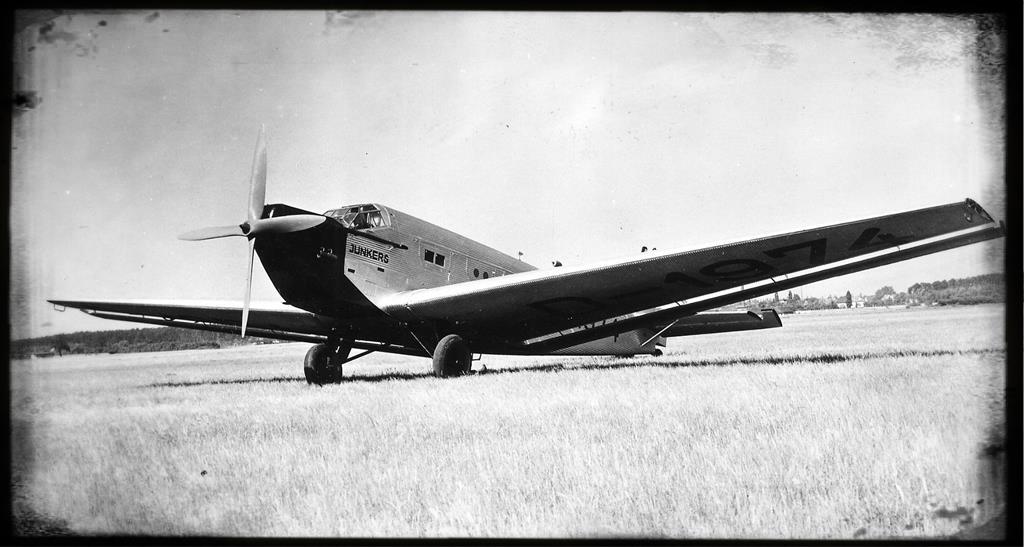
Single engined Ju52-1m
The Junkers Ju52 was one of the most sucessfull designs of Hugo Junkers and Junkers Flugzeugwerke. The design was started in 1928 as EF30 by Zindel and was principly based on the W33/W34. Like its precessors, the Ju52 was designed as a cargo aircraft, which should offer more capacity than the earlier designs. First designs saw a highlevel monoplane with one and two engines, but later Zindel changed the design to cantilever monoplane with one engine similar to the F24. These single-engined Ju52 were later designated as Ju52/1m.
First Flight was performed by Zimmermann on September, 3rd 1930. In November 1930 the aircraft was first presented to the German Forces and in December 1930 the aircraft was certificated by the DVL. In February 1931 the aircraft was presented to the public for the first time at Tempelhof Airport. Initial operational tests were performed in June 1931, when the prototype was delivered to Luftfrako, a German cargo operator After the end of the operational trials, the aircraft was returned to Junkers. The second prototype was converted into a seaplane in July 1931 and was first flown from Zimmermann on July 17th 1931 on river Elbe. The production for the first 12 aircraft of the Ju52/1m was started in 1930. But Junkers failed in his forecast for the demand of larger cargo aircraft. Just one Ju52/1m could be sold to Canada. When the first seven aircraft were finished, Junkers decided to stop further production of this type. The fuselage of the 8th to 12th aircraft were converted to the improved Ju52/3m standard. The remaining Ju52/1m's later were taken over by the Luftwaffe and were used as target aircraft. 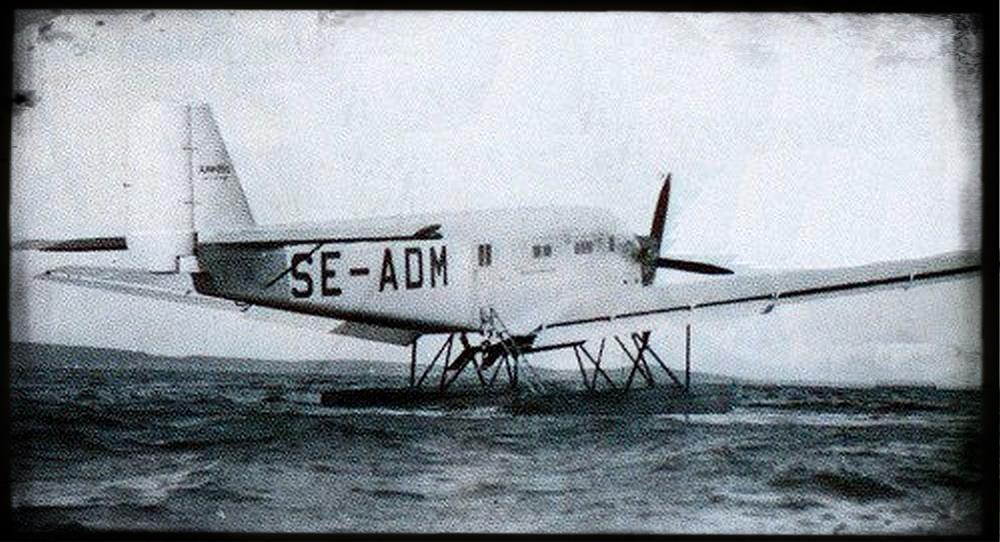 Junkers Ju52-1m / AB Flygindustri K45
Junkers Ju52-1m / AB Flygindustri K45
with torpedo mountings at lower fuselage
Like most Junkers aircraft designs of the 20s and early 30s, Junkers and Zindel also developed a militarized version of the Junkers Ju52. One of the seven prototypes (c/n 4004) was flown to A.B. Flygindustri at Limhamn in Sweden. In Sweden mountings for torpedos were added to the aircraft and it was registered in Sweden as SE-ADM. This torpedo bomber was designated as K45c. The K45c was flown back to Germany and was used by Junkers and Luftwaffe for experimental torpedo bombings. Like the other Ju52/1m's the K45c was later used as a target aircraft by Luftdienst GmbH. No further military conversions were made for the Ju52/1m. 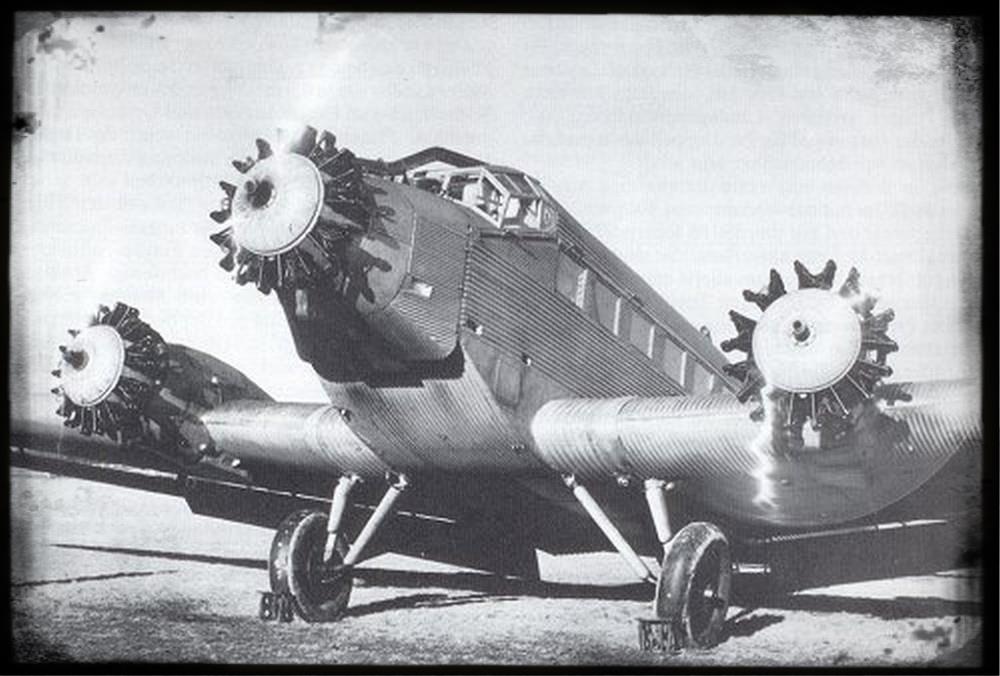
Junkers Ju52-3mce Prototype of 1932
When Junkers and Zindel realized, that the demand for a large cargo aircraft was not sufficent enough they planned to convert the aircraft into a passenger aircraft. For more safety and reliablity they decided to convert the single-engined cargo aircraft into a three-engined aircraft. Initial studies for this three-engined Ju52/3m were started in April 1931, when a Ju52/1m was equipped with two engine mockups on its wings to get some experience upon the increasing drag of the two additional engines. In Bolivia Lloyd Aero Boliviano (LAB) became interested in this airliner design and placed an initial order for two Ju52/3m. As no customer was available for c/n 4008, which was under construction at this time, this aircraft was converted during its construction to a Ju52/3m. On March 7th, 1932 this aircraft took off for the first flight of a three-engined Ju52.
The Ju52/3m became a very sucessfull aircraft from its beginnings. Following LAB, further orders were placed by Finland, Sweden and Romania, where the Federation Aeronautica Internationale (FAI) ordered perhaps the world's first VIP aircraft with an exclusive and highly comfortable cabin for the FAI president. Lufthansa's first Ju52/3m flew first in May 1932. The Ju52/3m became the backbone of Lufthansa's fleet until the end of WWII and the dissolve of the airline itself. On August 25th 1932 Lufthansa's first Ju52/3m D-2201 participated at the Alp Round Flight. Lufthansa itself used this competition to compare the three major airliners of these days, the Dornier Do K, the Fokker F XII and the Ju52/3m. The Ju52/3m was the absolute winner of this roundtrip. During the following months Lufthansa checked the reliablity of the Ju52 enroute the difficult Alproute from Munich to Milano and Rome. Following these sucessfull tests numerous of orders were received from airlines all over the world. The Ju52/3m passenger airliner was sold to Argentina, Brasil, Uruguay, Ecuador, Peru, Mexico, South Africa, Denmark, Norway, Italy, UK, Belgium, Hungary, Estonia, Greece and Spain. A total of 400 passenger airliners were sold until the breakout of WWII. Hugo Junkers himself was only able to influence the Ju52 developement during the first two years. In 1934 he was pushed out of his own company by the Nazi government. However the Ju52 production survived Hugo Junkers for years. Still in the final phases of WWII and after the end of WWII in France and Spain Ju52s were produced in large quantities. 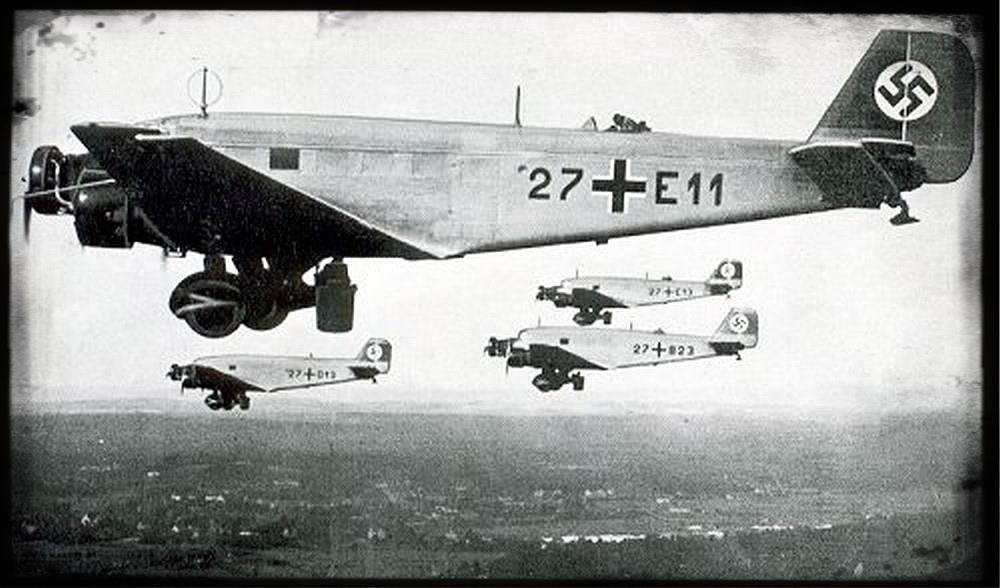
Junkers Ju52-3m/g3e of 1934
The Junkers Ju52/3m was a pure civil aircraft until 1935, when the Nazis announced the foundation of an official Luftwaffe in Germany. At this time the RLM was looking for an adequate bomber aircraft in Germany, which would become available shortly. But most German aircraft did not fit with the RLM demand. Therefore the RLM decided to use the Ju52/3m as a temporary bomber solution until dedicated bomber aircraft would become available in Germany. In 1934 the Junkers Flugzeugwerke received an order for a total of 1200 Ju52/3m bomber aircraft. Zindel redesigned the Ju52/3m and added two machine gun turrets in the rear cabin, one in the roof and one in the bottom of the aircraft. The passenger cabin was redesigned as the bomb compartement, where up to 32 50kg-bombs could be put in. It might be, that the developement of the Ju52 bomber version was done under the designator K45/3m, but this designator was already dropped before the Ju52 bomber developement was finished. There are currently no official documents known, which use this designator. As the Ju52 bomber was developed from the Ju52/3mge officially these bombers were designated Ju52/3mg3e. 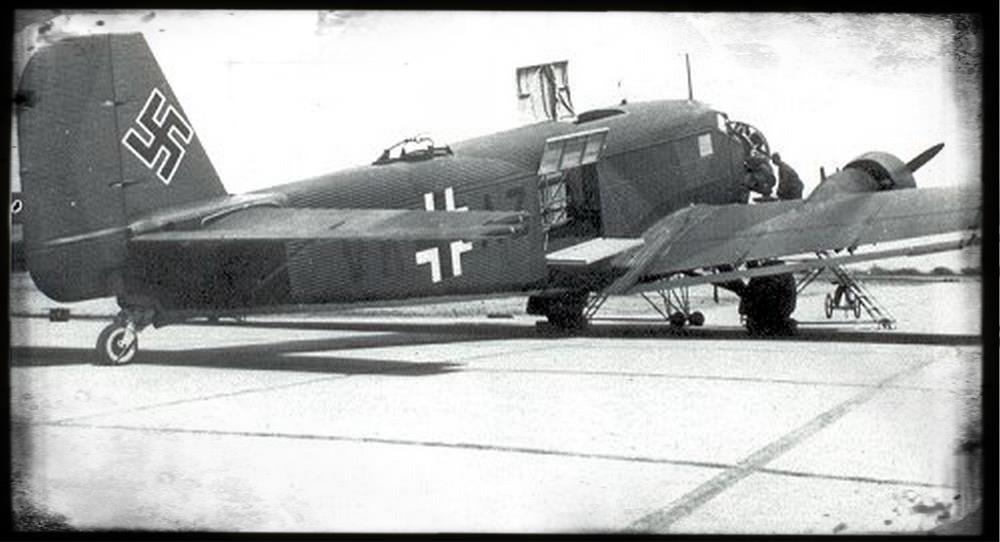
Junkers Ju52-3m/g7e
The RLM order was the largest, which Junkers ever received until 1934. The production plants at Dessau were insufficent to fullfill the RLM request of 450 aircraft until September 1935. Klaus Junkers and the production plant manager Thiedemann were forced to introduce a real serial production plant and had to reorganize all working processes. Nevertheless, it was obvious, that Dessau would never be capable for an output of 60 aircraft per month. The annual production rate of the Ju52 in 1934 was at about 18 aircraft per year. With the support of the RLM a license production series was set up at Weser Flugzeugbau and a new Junkers facility was set up at Bernburg. Just about 70 of these Ju52/3mg3e were built at Dessau. The remaining aircraft were produced at Bernburg and Bremen-Einswarden, since 1935/36 also at ATG in Leipzig.
In July 1936 a total of 20 Ju52/3mge were sent to Spain, where the Civil War was on its way. These aircraft became the first aircraft of the newly formed Luftwaffe to enter war action. Offically these aircraft were transfered to Hispano Marrocian Transport AG (HISMA) at Tetuan. While the aircraft at first were used for transport missions, they were used as bombers as well since August 1936 and combined within the Kampfgruppe K88. On November 4th 1936 the first Ju52 was shot down by Russian fighters near Madrid. Further 6 aircraft were shot down during the next few weeks. It became obvious, that the Ju52 was too slow and all Ju52 bombers were retired in Spain until April 1937. Nevertheless these Ju52s continued their service as transport aircraft. The remaining 14 aircraft were handed over to Franco, when the Legion Condor returned to Germany. Following the experiences in Spain, the RLM stopped the production of the Ju52/3m bombers. But the Ju52s had proved their capabilities for transport missions in Spain. Therefore the RLM declared the Ju52 as the standard transport aircraft of the Luftwaffe. Between 1935 and 1944 a total of 14 different Ju52 transporters were designed by Junkers Flugzeugwerke. 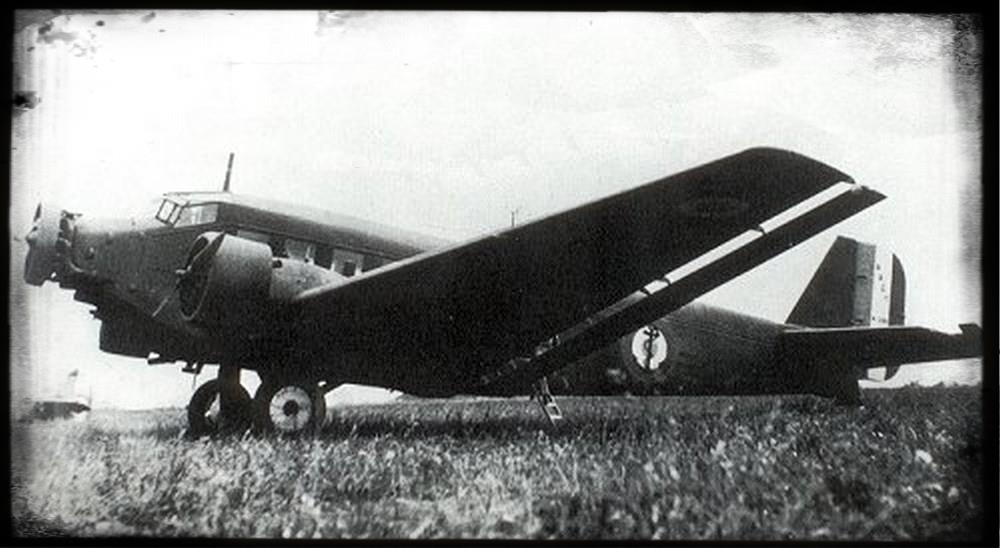
Junkers Ju52-3m/g10e /// Amiot AAC.1
French Navy in 1960
The military Ju52/3mge transporters were built until 1944. They were also delivered to foreign countries like Austria and Hungary. During the war the Ju52 was also produced at Amiot in Colombes, France. About 400 Ju52s were built here including about 150 aircraft, which were built after the end of WWII for the French Army under the designator AAC.1 Toucan. 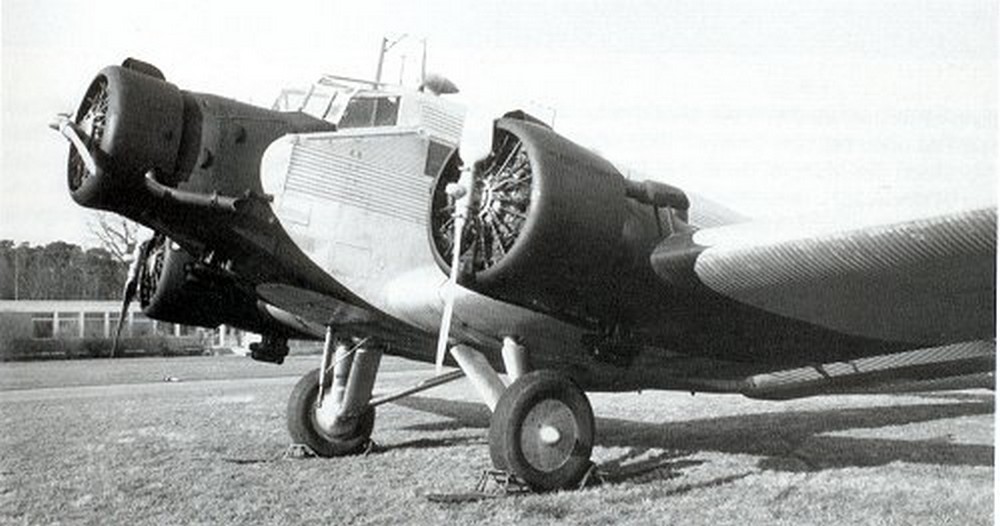
Junkers Ju52 /// Casa 352 from Spain
In Spain the Ju52s were built under license by CASA. The production started in the very late phases of WWII and most of the 170 aircraft were built after WWII for the Spanish Air Force. They were designated as CASA 352. As the BMW132s were no longer available after WWII a production of this engine was also started at Elizade SA at Barcelona. Therefore the engine cowlings of the center engine had to be modified from the original Ju52 Standard, which makes it easy to identify the Casa built Ju52 with its longer engine cowlings at the nose section. The Spanish Air Force used the CASA 352 until the early 70s, some of them were also used in Portugal. The last retirement from official use of a Ju52 was performed by the Swiss Air Force, which employed three original Ju52s since 1938. These aircraft were retired in 1984. But still today some Ju52s are in operation for nostalgic flights. They are operated by Lufthansa, South African Airways and Ju-Air. In sofar the Ju52 is still in the air 67 years after its first flight. A total of 4835 aircraft were built, most of them military transporters, which suffered severe losses in combat due to the slow speed of the Ju52. The Junkers Ju52 was the last Junkers aircraft completely built in corrugated Duralumin. During the years until WWII, Lufthansa used the Ju52/3m for several outstanding flights throughout the world:
24.08.1937 Crossing of the Pamir in Nepal
In August 1937 Lufthansa was looking for a routing from Berlin towards China. A natural barrier for the flight of a passenger airliner on the Southern routes were the Pamir mountains. On 24 August 1937 the Lufthansa pilot Untucht, Freiherr v. Gablenz and the radio operator Kirchhoff on board of Ju52/3m D-ANOY became the first crew to cross the Pamir mountains at an altitude of 7000 meters with a passenger airliner.
Technical Data:
Only several subtypes are shown in details
For type description see below table
| Aircraft | year | engine | length in m | span in m | wing area im sqm | net weight in kg | payload in kg | seats | speed in km/h | range in km |
|---|---|---|---|---|---|---|---|---|---|---|
| Ju52/1mba | 1931 | 1 x Junkers L88 (588kW) | n.a | n.a | n.a | n.a | n.a | 2 | n.a | n.a |
| K45c, ce | 1932 | 1 x BMW VIIaU | n.a. | n.a. | n.a. | n.a. | n.a. | n.a. | n.a. | n.a. |
Subtype Description:
Ju52/1mba, Ju52/1m prototype with Junkers L88 engine, Sept. 1931, only testflights
Ju52/1mbe, Ju52/1m prototype with BMW VIIaU of Sept. 1930
Ju52/1mbi, second prototype with A.S. Leopard engine in March 1932, initial landplane
Ju52/1mcai, with BMW IXU engine in 1933 (5th aircraft)
Ju52/1mcao, with Rolls Royce Bussard, export version for Canada (6th aircraft)
Ju52/1mce, increased wing swept and V-wing, 3rd, 4th and 7th aircraft, take off weight 7200kg
Ju52/1mci, second prototype after conversion into seaplane, July 1931
Ju52/1mdi, second prototype with strengthened undercarriage and wing, increased wing swept
Ju52/1mdo, testbed for Jumo 4 testflights (original prototype converted)
K45c, one test aircraft as torpedo bomber by A.B Flygindustri
Ju52/3mba was a VIP version for FAI president Bibesco, built in 1932
Ju52/3mce original Ju52/3m with Pratt+Whitney Hornet or BMW 132 since 1931
Ju52/3mci was a planned version for Sweden with Wasp engines, not built
Ju52/3mde, seaplane version, converted from Ju52/1m, Bolivia and Colombia
Ju52/3mfe, traffic version of LH with BMW132A3, NACA-cowlings, single part fuselage, about a dozen built in 1933
Ju52/3mf1e, training version of DVS with BMW Hornet since 1933, also used by DLH
Ju52/3mge traffic version since 1934 with BMW Hornet 132A, rear wheel
Ju52/3mge SA3, like 3mge with radio navigation equipment
Ju52/3mg1e and 3mg2e wiht BMW 132A/C/E for traffic services
Ju52/3mg3e, bomber with 3 x BMW 132A2 of 1935 with 9500kg T/O weight
Ju52/3mg4eA or ge4St or ge4N, military transporter with BMW132A3, T/O weight 10500kg
Ju52/3mg4eR, military travelling aircraft
Ju52/3mg4eH, training aircraft for navigation schools
Ju52/3mg4eF, parachut transporter
Ju52/3mg5e, military transporter with BMW132T, transporter aircraft with T/O weigt 11000kg, built since 1941
Ju52/3mg6e, military transporter as g5e, built in 1944
Ju52/3mg7e, military transporter as g5e with deicing capabilties
Ju52/3mg8e, military transporter as g5e
Ju52/3mg8e SA10, mine searching
Ju52/3mg9e, as g4e for tropical regions
Ju52/3mg10e with BMW132Z, transporter aircraft with side cargo door (subtypes E, F and St as 4me)
Ju52/3mg11e as g10e with anti icing
Ju52/3mg12e, military transporter as g11e with BMW 132T
Ju52/3mg14e, multipurpose transporter as g8e with BMW132L and improved armor, 1943/1944
Ju52/3mho, traffic version with 3 x Jumo 205C (441kW), only two built
Ju52/3mkao, engine testbed with 2 x BMW132A and 1 x BMW132F or BMW132N
Ju52/3mlu traffic version with Piaggio Stella X (520kW) for Italy. Later Alfa Romeo 126 RC/34
Ju52/3mmao like kao with NACA cowling since 1937
Ju52/3mnai, traffic version with P&W Wasp for Sweden and Great Britan
Ju52/3mreo, traffic version with BMW132Da/Dc for South America since 1937
Ju52/3msai, traffic version with P&W Wasp for Sweden and South America
Ju52/3mte traffic version with BMW 132K since 1937, max speed 300km/h
Ju52/3mZ5 traffic version with BMW132Z3, built during WWII as export version for Finland
K45/3m, military developement of the Ju52/3m for Chilean Air Force in 1932/33, not built
AAC.1, military Ju52/3mg11e built at Amiot in France, production continued after WWII, 415 built
CASA 352, military Ju52s built under license at CASA in Spain after WWII with BMW132A, 106 built
CASA 352L, improved CASA352 with Spanish ENMASA B3 engines, 64 built
C79, U.S. designator for a USAF Ju52 taken over from SEDTA
D52, Czech designator for used Ju52s after WWII
Tp5, Swedish Air Force designator for ex A.B. Aerotransport Ju52s.
Weblinks:
- Airwar.ru - Ju52/1m Story, Data, Photos
- Junkers.de - Ju52/1m Story, Data
- Fliegerweb.com - Ju52/1m Story, Data, Photos, Serials
- Wikipedia.org - Ju52 Story, Data
- Ju52Archiv.de - Story, Data, Photos, Production List, Survivors
- Youtube.com - Ju52/1m Movie by WC Aviation Museum
- Youtube.com - Ernst Zindel interview about the Ju52 at ILA 1965
Literature:
- Günther Ott
Die einmotorige Junkers Ju52
in: Luftfahrt International 4/1981
Download PDF here: ADL Luftfahrthistorik - Wolfgang Miertsch
Vom Original zum Modell: Junkers Ju52
Bernard + Graefe Verlag, 1998, ISBN: 3-7637-6015-6 - A.W. Krueger
Flugzeug Profile: Junkers Ju52
Flugzeug Publikations GmbH, 1997 - Manfred Griehl
Die Ju52 weltweit im Einsatz
Podzun-Pallas, 1997, ISBN No. 3790906158
- Heinz Nowarra
Minensuchgruppe Mausi
Flugzeug Publikations GmbH, 1997, ISBN No. 3-927132-26-8 - Heinz Nowarra
Junkers Ju52
Schiffer Publications, 1993, ISBN No. 887405231 - B. Kempski
Samolot transportowy Junkers Ju52/3m
Belona, 1991, ISBN No. 83-11-07927-7 - Hans Jürgen Becker
Flugzeuge, die Geschichte machten - Ju52
Motorbuch Verlag, 1991, ISBN No. 3-613-01420-3
introduced Jul 1996, transfered Jul 2017
http://hugojunkers.bplaced.net/
contents last updated 2 Mar 2002

